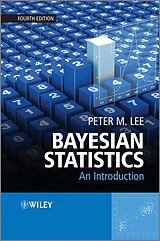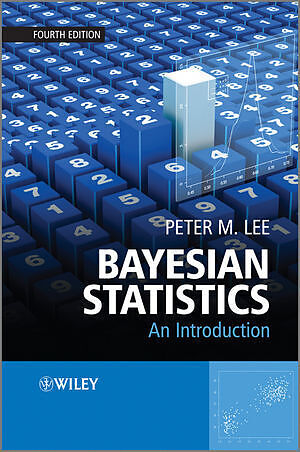Bayesian Statistics
Einband:
Kartonierter Einband
EAN:
9781118332573
Genre:
Maths
Autor:
Lee Peter M.
Herausgeber:
John Wiley & Sons
Erscheinungsdatum:
03.08.2012
Bayesian Statistics is the school of thought that combines prior beliefs with the likelihood of a hypothesis to arrive at posterior beliefs. The first edition of Peter Lee's book appeared in 1989, but the subject has moved ever onwards, with increasing emphasis on Monte Carlo based techniques.
"- Presents extensive examples throughout the book to complement the theory presented.Includes significant new material on recent techniques such as variational methods, importance sampling, approximate computation and reversible jump MCMC"--
Autorentext
Peter Lee, Department of Mathematics & Formerly Provost of Wentworth College, University of York.
Inhalt
Preface xix Preface to the First Edition xxi 1 Preliminaries 1 1.1 Probability and Bayes' Theorem 1 1.1.1 Notation 1 1.1.2 Axioms for probability 2 1.1.3 'Unconditional' probability 5 1.1.4 Odds 6 1.1.5 Independence 7 1.1.6 Some simple consequences of the axioms; Bayes' Theorem 7 1.2 Examples on Bayes' Theorem 9 1.2.1 The Biology of Twins 9 1.2.2 A political example 10 1.2.3 A warning 10 1.3 Random variables 12 1.3.1 Discrete random variables 12 1.3.2 The binomial distribution 13 1.3.3 Continuous random variables 14 1.3.4 The normal distribution 16 1.3.5 Mixed random variables 17 1.4 Several random variables 17 1.4.1 Two discrete random variables 17 1.4.2 Two continuous random variables 18 1.4.3 Bayes' Theorem for random variables 20 1.4.4 Example 21 1.4.5 One discrete variable and one continuous variable 21 1.4.6 Independent random variables 22 1.5 Means and variances 23 1.5.1 Expectations 23 1.5.2 The expectation of a sum and of a product 24 1.5.3 Variance, precision and standard deviation 25 1.5.4 Examples 25 1.5.5 Variance of a sum; covariance and correlation 27 1.5.6 Approximations to the mean and variance of a function of a random variable 28 1.5.7 Conditional expectations and variances 29 1.5.8 Medians and modes 31 1.6 Exercises on Chapter 1 31 2 Bayesian inference for the normal distribution 36 2.1 Nature of Bayesian inference 36 2.1.1 Preliminary remarks 36 2.1.2 Post is prior times likelihood 36 2.1.3 Likelihood can be multiplied by any constant 38 2.1.4 Sequential use of Bayes' Theorem 38 2.1.5 The predictive distribution 39 2.1.6 A warning 39 2.2 Normal prior and likelihood 40 2.2.1 Posterior from a normal prior and likelihood 40 2.2.2 Example 42 2.2.3 Predictive distribution 43 2.2.4 The nature of the assumptions made 44 2.3 Several normal observations with a normal prior 44 2.3.1 Posterior distribution 44 2.3.2 Example 46 2.3.3 Predictive distribution 47 2.3.4 Robustness 47 2.4 Dominant likelihoods 48 2.4.1 Improper priors 48 2.4.2 Approximation of proper priors by improper priors 49 2.5 Locally uniform priors 50 2.5.1 Bayes' postulate 50 2.5.2 Data translated likelihoods 52 2.5.3 Transformation of unknown parameters 52 2.6 Highest density regions 54 2.6.1 Need for summaries of posterior information 54 2.6.2 Relation to classical statistics 55 2.7 Normal variance 55 2.7.1 A suitable prior for the normal variance 55 2.7.2 Reference prior for the normal variance 58 2.8 HDRs for the normal variance 59 2.8.1 What distribution should we be considering? 59 2.8.2 Example 59 2.9 The role of sufficiency 60 2.9.1 Definition of sufficiency 60 2.9.2 Neyman's factorization theorem 61 2.9.3 Sufficiency principle 63 2.9.4 Examples 63 2.9.5 Order statistics and minimal sufficient statistics 65 2.9.6 Examples on minimal sufficiency 66 2.10 Conjugate prior distributions 67 2.10.1 Definition and difficulties 67 2.10.2 Examples 68 2.10.3 Mixtures of conjugate densities 69 2.10.4 Is your prior really conjugate? 71 2.11 The exponential family 71 2.11.1 Definition 71 2.11.2 Examples 72 2.11.3 Conjugate densities 72 2.11.4 Two-parameter exponential family 73 2.12 Normal mean and variance both unknown 73 2.12.1 Formulation of the problem 73 2.12.2 Marginal distribution of the mean 75 2.12.3 Example of the posterior density for the mean 76 2.12.4 Marginal distribution of the variance 77 2.12.5 Example of the posterior density of the variance 77 2.12.6 Conditional density of the mean for given variance 77 2.13 Conjugate joint prior for the normal distribution 78 2.13.1 The form of the conjugate prior 78 2.13.2 Derivation of the posterior 80 2.13.3 Example 81 2.13.4 Concluding remarks 82 2.14 Exercises on Chapter 2 82 3 Some other common distributions 85 3.1 The binomial distribution 85 3.1.1 Conjugate prior 85 3.1.2 Odds and log-odds 88 3.1.3 Highest density regions 90 3.1.4 Example 91 3.1.5 Predictive distribution 92 3.2 Reference prior for the binomial likelihood 92 3.2.1 Bayes' postulate 92 3.2.2 Haldane's prior 93 3.2.3 The arc-sine distribution 94 3.2.4 Conclusion 95 3.3 Jeffreys' rule 96 3.3.1 Fisher's information 96 3.3.2 The information from several observations 97 3.3.3 Jeffreys' prior 98 3.3.4 Examples 98 3.3.5 Warning 100 3.3.6 Several unknown parameters 100 3.3.7 Example 101 3.4 The Poisson distribution 102 3.4.1 Conjugate prior 102 3.4.2 Reference prior 103 3.4.3 Example 104 3.4.4 Predictive distribution 104 3.5 The uniform distribution 106 3.5.1 Preliminary definitions 106 3.5.2 Uniform distribution with a fixed lower endpoint 107 3.5.3 The general uniform distribution 108 3.5.4 Examples 110 3.6 Reference prior for the uniform distribution 110 3.6.1 Lower limit of the interval fixed 110 3.6.2 Example 111 3.6.3 Both limits unknown 111 3.7 The tramcar problem 113 3.7.1 The discrete uniform distribution 113 3.8 The first digit problem; invariant priors 114 3.8.1 A prior in search of an explanation 114 3.8.2 The problem 114 3.8.3 A solution 115 3.8.4 Haar priors 117 3.9 The circular normal distribution 117 3.9.1 Distributions on the circle 117 3.9.2 Example 119 3.9.3 Construction of an HDR by numerical integration 120 3.9.4 Remarks 122 3.10 Approximations based on the likelihood 122 3.10.1 Maximum likelihood 122 3.10.2 Iterative methods 123 3.10.3 Approximation to the posterior density 123 3.10.4 Examples 124 3.10.5 Extension to more than one parameter 126 3.10.6 Example 127 3.11 Reference posterior distributions 128 3.11.1 The information provided by an experiment 128 3.11.2 Reference priors under asymptotic normality 130 3.11.3 Uniform distribution of unit length 131 3.11.4 Normal mean and variance 132 3.11.5 Technical complications 134 3.12 Exercises on Chapter 3 134 4 Hypothesis testing 138 4.1 Hypothesis testing 138 4.1.1 Introduction 138 4.1.2 Classical hypothesis testing 138 4.1.3 Difficulties with the classical approach 139 4.1.4 The Bayesian approach 140 4.1.5 Example 142 4.1.6 Comment 143 4.2 One-sided hypothesis tests 143 4.2.1 Definition 143 4.2.2 P-values 144 4.3 Lindley's method 145 4.3.1 A compromis…

Leider konnten wir für diesen Artikel keine Preise ermitteln ...
billigbuch.ch sucht jetzt für Sie die besten Angebote ...
Die aktuellen Verkaufspreise von 6 Onlineshops werden in Realtime abgefragt.
Sie können das gewünschte Produkt anschliessend direkt beim Anbieter Ihrer Wahl bestellen.
Loading...
Die aktuellen Verkaufspreise von 6 Onlineshops werden in Realtime abgefragt.
Sie können das gewünschte Produkt anschliessend direkt beim Anbieter Ihrer Wahl bestellen.
| # | Onlineshop | Preis CHF | Versand CHF | Total CHF | ||
|---|---|---|---|---|---|---|
| 1 | Seller | 0.00 | 0.00 | 0.00 |
